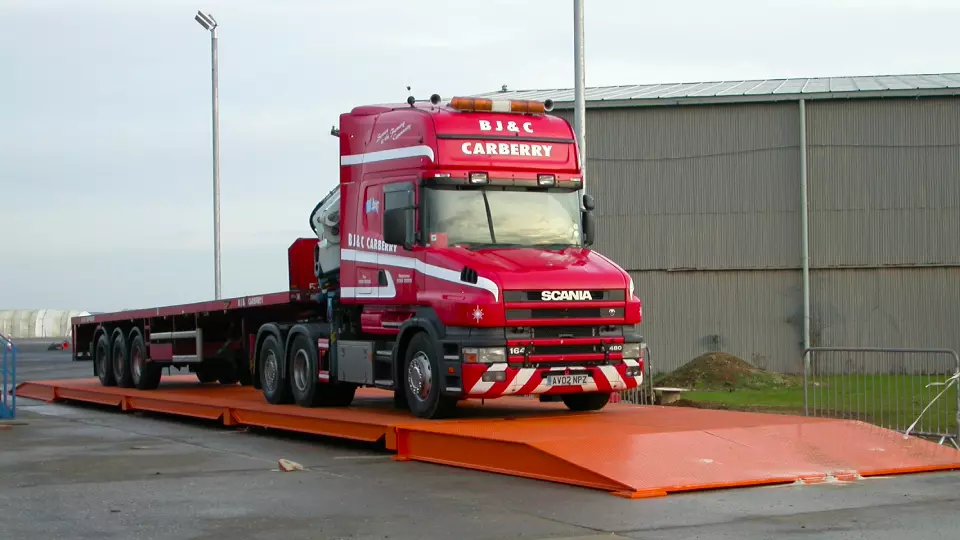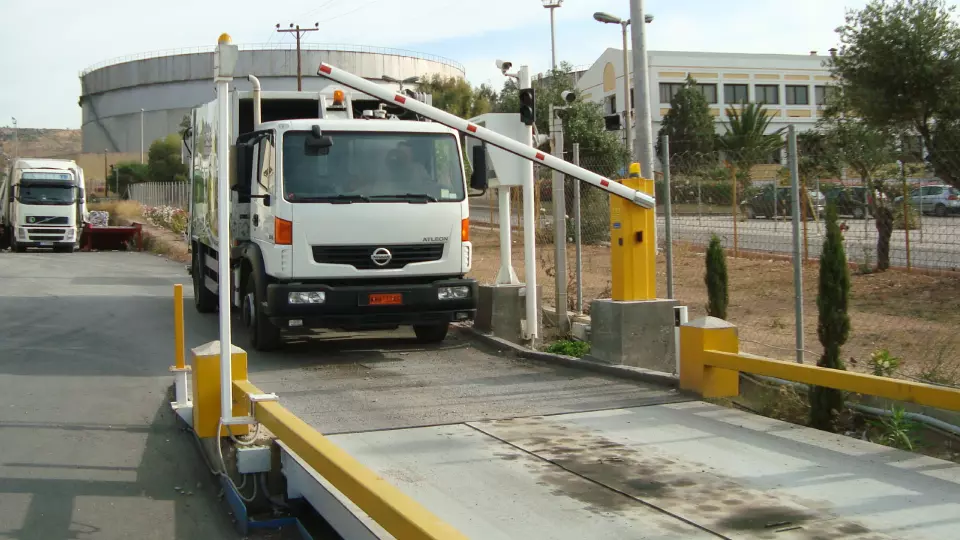Although modern transport infrastructures are built to withstand heavy traffic and trucks transporting heavy cargo, an extreme load can affect the structural integrity of roads. Most highways and roads experience extensive wear and tear, especially when truckers haul doubles and triples.
To ensure that roads retain their structural integrity, the US Department of Transportation (DOT) has enforced stringent regulations and inspection procedures on weight limits. As a result, carriers are legally required to ensure their trucks are within the weight limits, giving rise to truck weigh stations.
Weigh stations are designated US DOT checkpoints installed on most highways where inspectors or state highway patrols stop and weigh trucks to assess their gross weight.
In this article, we’ll dive deeper into truck weigh stations and explain how they work, their purpose, and the different weighing technologies used. We’ll also talk about regulatory compliances and levels of inspections and share the best practices for truckers at weigh stations.
What Are Weigh Stations for Trucks?
Weigh stations are specialized facilities typically located on highways and ports of entry near state borders. These stations are managed by state transportation regulatory bodies and designed to weigh commercial vehicles, mainly box, and semi-trucks, to assess their gross weight.

Although trucking companies and owner-operators are well aware of the legal weight limit, exceeding the limit (sometimes unintentionally) can occur due to a variety of reasons. As a result, weigh stations have become necessary in the industry, especially on the busiest commercial trucking routes.
What Is The Purpose Of Weigh Stations?
The primary purpose of weigh stations is to reduce the rate of infrastructure wear and protect the structural integrity of roads and highways. Overweight freight-hauling trucks are responsible for the majority of the damage caused to infrastructure.
Hence, DOT officials are assigned to these facilities to ensure all trucks operate according to their weight classes and legal federal limits as below:
- Total allowable gross weight: 80,000 pounds
- Tandem axle maximum gross weight: 34,000 pounds
- Single axle maximum gross weight: 20,000 pounds
Moreover, weigh stations also offer various indirect benefits. For instance, they can reduce the risk of accidents, as overweight trucks are more prone to collisions and mechanical failure. Secondly, they help maintain healthy competition in the industry by stopping truckers from exceeding the weight limits in an attempt to reduce their cost per mile.
How Do Weigh Stations Work?
Weigh stations are typically installed on major highways near state borders and ports of entry. When you’re approaching one, you will see road signs and indicators asking you to stay in the right lane and slow down.

However, stations vary in terms of technology used, meaning the weighing process will vary accordingly. Depending on the weighing technology used or whether a truck driver has gotten pre-clearance, a truck may or may not need to turn into a weigh station.
Important Note: In the United States, if a weigh station is closed, a truck driver can carry on their journey without needing to undergo weight checks. It is important to note that without pre-clearance, it is mandatory to get your truck weighed if the station is open.
Traditionally, truckers would be directed to a designated area equipped with a certified scale. Once the check is complete, they would be asked to continue their journey or undergo further safety inspections.
Weighing Technologies
Below are the two most common types of technologies used to weigh trucks at weigh stations and private weighing facilities:
Static Scales
Most truck weigh stations and facilities have built-in static scales that can weigh stationary or very slow-moving trucks. Some static scales can be used to measure each axle individually by prompting the driver to reposition their truck after each axle is measured. However, modern stations have portable scales that can be moved from one place to another, accelerating the process, especially during peak hours.
Weigh-In-Motion (WIM) Scales
Weigh-in-Motion (WIM) scales are the most common technology used to weigh trucks in the modern age. These embedded scales can weigh trucks while they’re in motion. Hence, there’s no need to exit the road and wait in line to weigh your truck at a checkpoint.
These scales are equipped with various compression or tension-based sensors and real-time imaging technology. Simply put, these stations can tell what type of vehicle is on the scale and how much each axle weighs while in motion.
Regulatory Compliances
All carriers and owner-operators operating trucks with a gross vehicle weight rating (GVWR) rating of 10,000 pounds or higher are legally required by DOT to weigh their trucks at weigh stations.
They must head to these facilities when they come across signage on highways directing them to do so. Failure to comply can result in significant fines and other penalties. However, the exact fines vary according to the requisite state’s DOT. On average, you can expect to pay $300 or more.
Failure to stop at a weigh station also reduces your fleet’s safety score and can put the driver at risk of suspension. In some cases, patrol officers might even ask drivers to turn around and drive back to the weigh station, regardless of the distance, which can increase their fuel costs unnecessarily.
Furthermore, if your truck exceeds the limit, you can expect to pay overweight fines anywhere from $100 to $10,000, depending on the number of offenses, exceeding weight, and other factors.
Levels of inspections
Freight-hauling trucks and drivers often undergo further inspections at weigh stations. Below are eight levels of inspections at weigh stations and their descriptions:
| Inspection Level | Description |
| Level I | Level I Inspection includes an examination of the truck driver’s CDL, duty status record, Medical Examiner’s Certificate, and complete vehicle inspection – brake systems, coupling devices, suspensions, lighting devices, and other components. |
| Level II | Level II Inspection typically involves a walk-around inspection of the driver and truck. The inspectors must examine all the items specified under Level I inspections. |
| Level III | Level III Inspection is a driver, credential, and administrative inspection in which examiners conduct all driver-related inspections along with traffic violations, hours of service, and infractions. This inspection does not include any inspections from Level I. |
| Level IV | Level IV Inspection is a one-time inspection done for a particular cargo item, driver-related aspect, or trend for the purpose of data gathering. |
| Level V | Level V Inspection is a vehicle-only inspection that includes all Level I inspections. The key difference is that this inspection can be conducted at any location without the driver present. |
| Level VI | Level VI Inspection is conducted by the US DOT on trucks transporting transuranic waste and highway route-controlled quantities of radioactive material. It is a comprehensive extension to Level I checks. |
| Level VII | Level VII Inspection is a jurisdictional mandated commercial vehicle inspection conducted by CVSA-certified inspectors and government employees. This inspection typically applies to passenger-carrying vehicles. |
| Level VIII | Level VIII Inspection includes all Level I Inspection items. However, unlike the latter, it is a purely electronic examination done remotely to verify driver’s license class, GPS coordinates, SPE, duty status, operating authority, etc. |
At weigh stations in the United States, truckers usually undergo Level I, Level II, and Level III inspections.
Pre-Clearance
Many trucking companies and owner-operators get a pre-clearance application to avoid stopping at a weigh station. This strategy can help them save time and fuel while improving their overall productivity.
Modern weigh stations are equipped with bypass systems from various providers that automatically check the truck’s safety and credential clearance status and send the screening result to the driver directly through the truck’s transponder.
Bypass services are available via smartphone apps that alert drivers of an approaching weigh station starting from within two miles and prompt drivers with multiple proximity alerts as they approach the station.
Once a driver is within close proximity of a weigh station, the application would display either a bypass clearance, instructions to turn in to the station, or prompts the driver to follow road signs.
Some are even compatible with electronic logging devices (ELDs). Drivers simply have to subscribe to a pre-clearance solution provider of their choice and pay the rates according to their safety and credential clearance status.
Best Practices for Truckers at Weigh Stations
Below are some of our most recommended practices for truckers with regard to weigh stations:
- Weigh Your Gross Vehicle Weight Beforehand – The best habit you can adopt is weighing your gross vehicle weight before approaching a US DOT weigh station. You can typically find weighing facilities at truck terminals or near highways and pay a small fee for using them. This way, you can proactively check if you’ve exceeded the weight limit and avoid penalties by the Department of Transportation.
- Ensure Your Vehicle Is Compliant – Secondly, you should check if your vehicle is compliant with US DOT regulations and carry out the required repairs or routine maintenance. For instance, ensuring your brake lights and tires are well-maintained and within regulatory compliance.
- Familiarize Yourself With State Regulations – Another important practice you should adopt is keeping tabs on your state’s DOT regulations. You should also study the regulations of any state you’re hauling cargo to as each state may have different requirements.
- Follow Signage and Indicators – Another important aspect of due diligence involves following all the signs on the road, especially those leading to weigh stations unless you have a pre-clearance application. Missing a weigh station can often result in heavy fines and time wastage if you’re stopped by a state patrol.
- Keep Necessary Documents On Hand – As a truck driver, you should always have all the necessary documents on hand, including your CDL, insurance, cargo documentation, etc. You can be stopped anytime and anywhere during transit for additional inspection by the DOT, even if you’ve already weighed your vehicle at a station.
- Communicate Clearly – Finally, when dealing with weighing personnel or DOT officials, try to be courteous and ask any questions you might have to prevent any issues that may result in fines or delays.

Get Free Course Access
If you enjoyed the article, don’t miss out on our free supply chain courses that help you stay ahead in your industry.

Andrew Lin
Co-Founder & Writer
at freightcourse
About the Author
Andrew is a multi-business owner with over 12 years of experience in the fields of logistics, trucking, manufacturing, operations, training, and education.
Being the co-founder of freightcourse has given him the ability to pursue his desire to educate others on manufacturing and supply chain topics.
Follow us